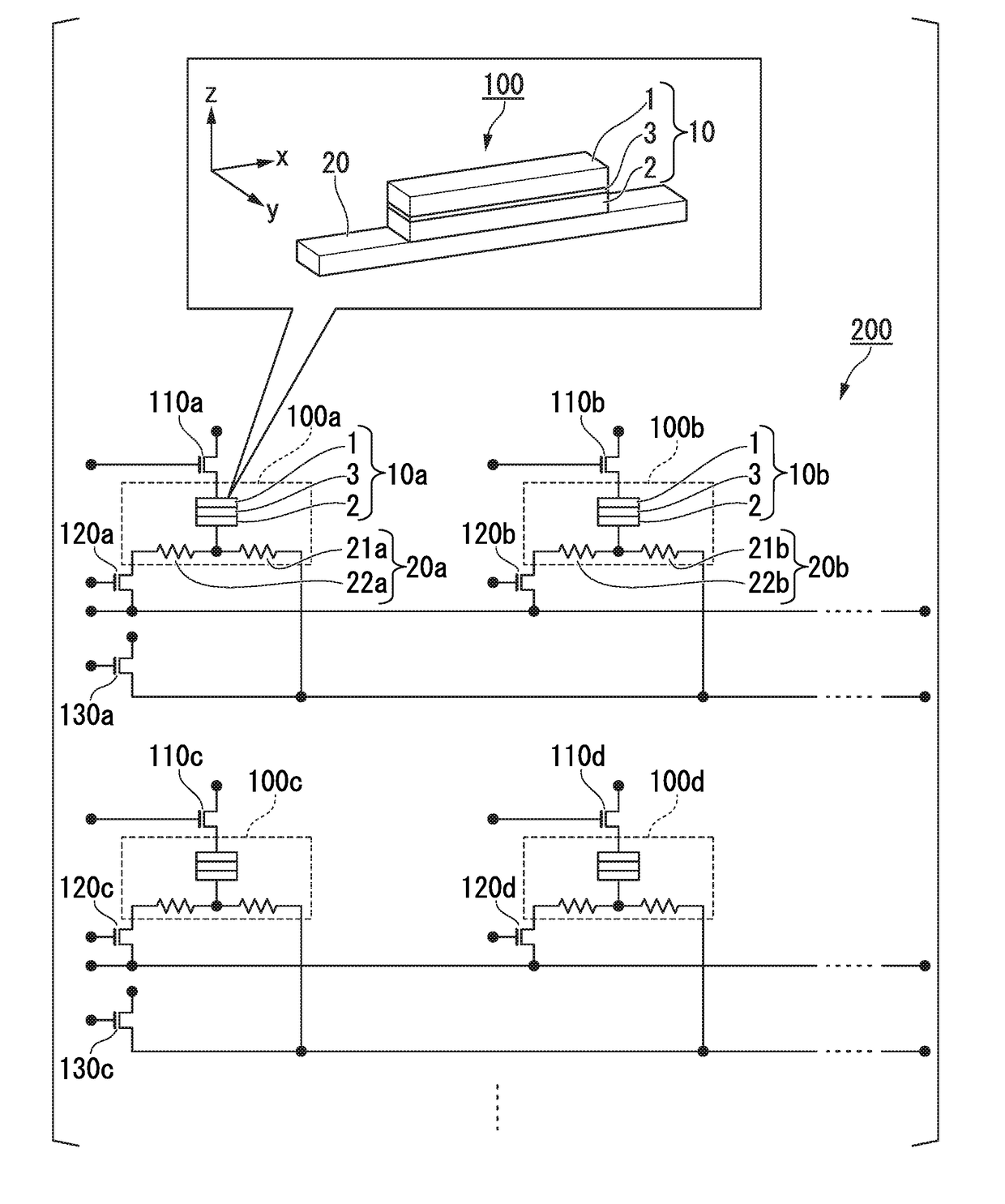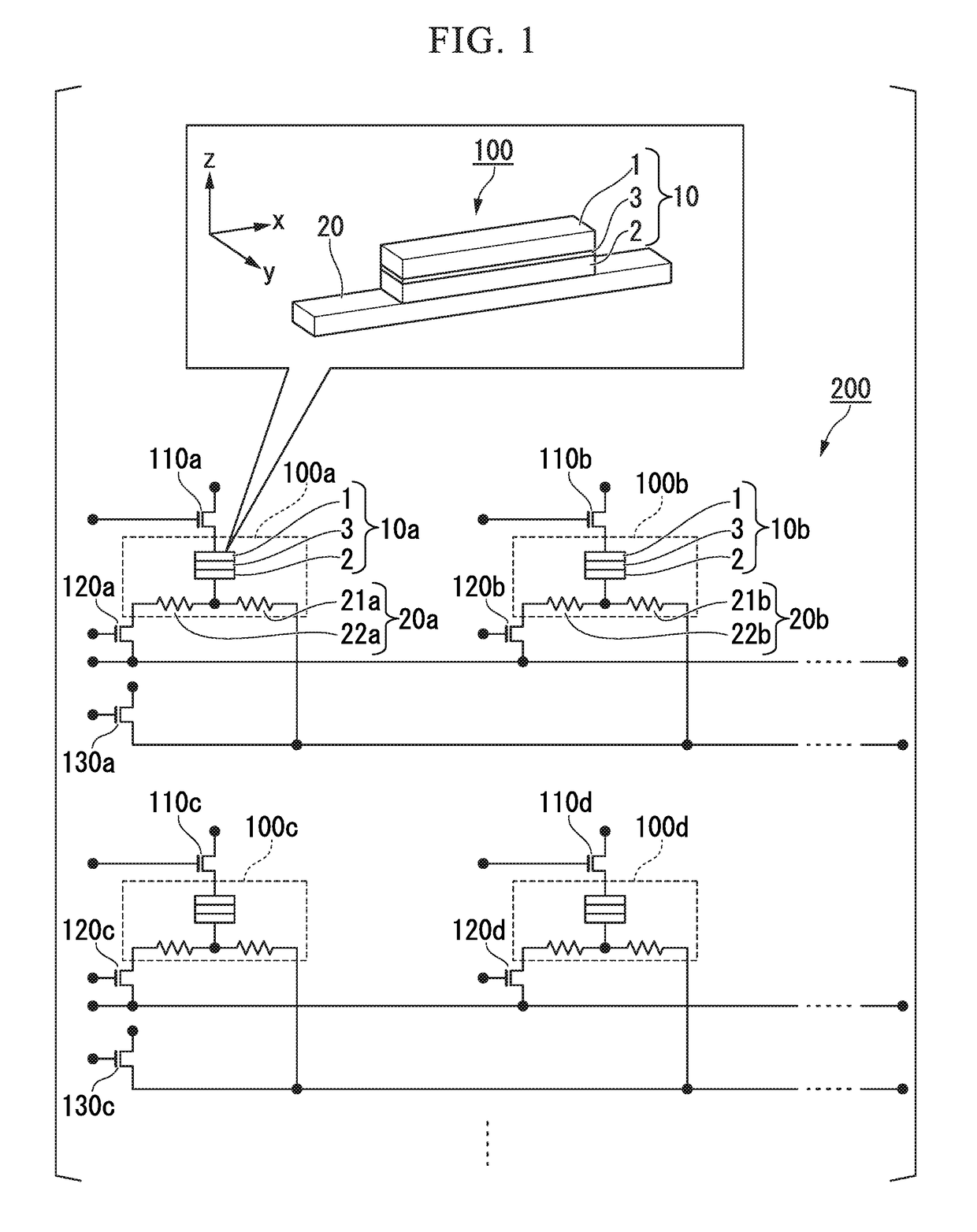Magnetic memory
a technology of magnetic memory and memory layer, applied in the field of magnetic memory, can solve the problems of increasing the amount of current needed for mram overall, affecting the operation life of the element, and affecting etc., and achieve the effect of raising the thermal stability of the magnetoresistance effect elemen
- Summary
- Abstract
- Description
- Claims
- Application Information
AI Technical Summary
Benefits of technology
Problems solved by technology
Method used
Image
Examples
first embodiment
[0046]A circuit example of the magnetic memory 200 will be explained. The operating principles and the like of the spin-orbit torque type magnetoresistance effect element will be explained below.
[0047]FIG. 1 is a circuit diagram of an example of the magnetic memory 200 according to the first embodiment. In FIG. 1, the stacking direction of the magnetoresistance effect element 10 is defined as the z-direction, the first direction in which the spin-orbit torque wiring 20 extends is defined as the x-direction, and the second direction which is orthogonal to both the z-direction and the x-direction is defined as the y-direction.
[0048]The magnetic memory 200 illustrated in FIG. 1 comprises spin-orbit torque
[0049](SOT) type magnetoresistance effect elements 100 (100a, 100b, 100c, 100d ), read control elements 110 (110a, 110b, 110c, 110d; first control elements), element selection control elements 120 (120a, 120b, 120c, 120d; second control elements) and write control elements 130 (130a, 1...
second embodiment
[0138]In the first embodiment, an example in which the write control elements 130, when viewed as a matrix, are shared by a plurality of spin-orbit torque type magnetoresistance effect elements 100 that are arranged in the lateral direction, has been explained. In the present embodiment, an example in which the read control elements 110, when viewed as a matrix, are shared by a plurality of spin-orbit torque type magnetoresistance effect elements 100 that are arranged in the longitudinal direction, will be explained.
[0139]FIG. 7 is a circuit diagram of an example of a magnetic memory 200A according to the second embodiment. In FIG. 7, the stacking direction of the magnetoresistance effect element 10 is defined as the z-direction, the first direction in which the spin-orbit torque wiring 20 extends is defined as the x-direction, and the second direction which is orthogonal to both the z-direction and the x-direction is defined as the y-direction.
[0140]The magnetic memory 200A illustr...
third embodiment
[0199]An example in which a magnetic memory according to an embodiment is applied to a magnetic-field-assisted SOT-MRAM will be explained.
[0200]FIG. 9 is a perspective view of a modification example of a spin-orbit torque type magnetoresistance effect element 100, a write control element 130, an element selection control element 120, spin-orbit torque wiring 20 and magnetic-field-providing wiring 192 according to the third embodiment, when arranged three-dimensionally. In the present embodiment, the channels in the write control element 130 and the element selection control element 120 are oriented in the x-direction. The coordinate system is the same as that in FIG. 2. In FIG. 9, reference numbers 181 to 183 respectively denote wiring provided in each layer. Reference number 161 denotes a through-via that connects wiring to wiring. Reference number 191 denotes an insulating layer. Reference number 192 denotes magnetic-field-providing wiring for applying a magnetic field in a direct...
PUM
 Login to View More
Login to View More Abstract
Description
Claims
Application Information
 Login to View More
Login to View More - R&D
- Intellectual Property
- Life Sciences
- Materials
- Tech Scout
- Unparalleled Data Quality
- Higher Quality Content
- 60% Fewer Hallucinations
Browse by: Latest US Patents, China's latest patents, Technical Efficacy Thesaurus, Application Domain, Technology Topic, Popular Technical Reports.
© 2025 PatSnap. All rights reserved.Legal|Privacy policy|Modern Slavery Act Transparency Statement|Sitemap|About US| Contact US: help@patsnap.com



